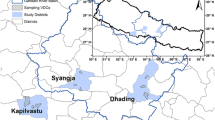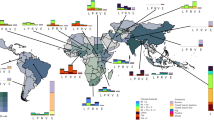Abstract
Sustaining industries dependent on climate-sensitive natural resources will require strategy given likely future scenarios under climate change. Tools and frameworks to evaluate the vulnerability of agriculture will be key if a plan to minimise vulnerability and maximise resilience is to be created. We use a framework based on a modification of the well-established IPCC vulnerability model (Marshall and Smajgl 2013) to assess the vulnerability of the livestock industry in Eastern Australia to climate change. Using existing data-sets, we show how the framework can be used to holistically quantify and qualify the current and future exposure of the industry to climate-related events, the biophysical and social sensitivity and impacts likely to be experienced, and the current level of adaptive capacity within the context of the livestock industry in eastern Australia. Results suggest that whilst the industry is likely to be sensitive to changes brought about by climate change, it is not necessarily vulnerable if livestock producers can moderate impacts by enhancing their adaptive capacity. Adaptive capacity is examined at the producer and industry level to understand the scope and potential for climate adaptation planning within the industry itself. We discuss six important challenges that the industry must face if it is to manage its vulnerability. Minimising vulnerability within the industry will require careful consideration of the likely ecological, biophysical and socio-economic impacts and an investment in adaptive capacity across scales.



Similar content being viewed by others
References
Adger WN (1999) Social vulnerability to climate change and extremes in coastal Vietnam. World Dev 27:249–269
Adger WN (2006) Vulnerability. Global Environ Change-Human Policy Dimens 16:268–281
Adger WN, Brown K, Barnett J, Marshall NA, O’Brien K (2012) Cultural dimensions of climate change impacts and adaptation. Nat Clim Change. doi:10.1038/nclimate1666
AgForce Queensland (2014) ‘Our policies—industry issues—carbon tax’ sourced online. (AOLC) http://www.agforceqld.org.au/index.php?tgtPage=policies&page_id=349. Accessed 10 Nov 2014
AgForce Queensland (AFDRGL) (2014) Natural disaster recovery: landholders guide, version 3. Sourced online. Accessed 10 Nov 2014
AgForce Queensland (AFS-AFCC) (2009) Submission to the House of Representatives Standing Committee on Primary Industries and Resources, Inquiry into the role of government in assisting Australian farmers to adapt to the impacts of climate change. March 2009
AgForce Queensland (AFS-Garnaut) (2008) Submission to climate change: land use—agriculture and forestry AgForce\Queensland submission, January 2008
AgForce Queensland (AOLD) (2014) ‘Our policies—industry issues—drought and natural disaster—drought.’ Sourced online. http://www.agforceqld.org.au/index.php?page_id=34. Accessed 10 Nov 2014
Allen CD, Macalady AK, Chenchouni H, Bachelet D, McDowell N, Vennetier M, Kitzberger T, Rigling A, Breshears DD, Hogg EH et al (2010) A global overview of drought and heat-induced tree mortality reveals emerging climate change risks for forests. For Ecol Manag 259(4):660–684
Australian Bureau of Statistics (2011) Census of population and housing. ABS, Canberra
Australian Bureau of Statistics (2012) Value of agricultural commodities produced, Australia, 2010–11, (cat. no. 7503.0), ABS, Canberra
Australian Bureau of Statistics (2013) Agricultural census 2010–11. ABS, Canberra
Bennett NJ, Dearden P, Murray G, Kadfak A (2014) The capacity to adapt?: communities in a changing climate, environment, and economy on the northern Andaman coast of Thailand. Ecol Soc 19(2):5
Bell AR, Cook BI, Anchukaitis KJ, Buckley BM, Cook ER (2011) Repurposing climate reconstructions for drought prediction in Southeast Asia. Clim Change 106:691–698
Berry HL, Hogan A, Owen J, Rickwood D, Fragar L (2011) Climate change and farmers’ mental health: risks and responses. Asia Pac J Public Health 23(2):119s–132s
Brooks N, Adger WN, Kelly MP (2005) The determinants of vulnerability and adaptive capacity at the national level and the implications for adaptation. Glob Environ Change Part A 15:151–163
Butler DW, Halford J (2014) Carbon farming and natural resource management in eastern Australia. Queensland Department of Science, Information Technology, Innovation and the Arts, Canberra
Cocklin C, Haw M, Mercer D (2000) A pinch of salt: landowner perception and adjustment to the salinity hazard in Victoria, Australia. J Rural Stud 16(2):155–169
Dowd AM, Marshall N, Fleming A, Jakku E, Gaillard E, Howden M (2014) The role of networks in transforming Australian agriculture. Nat Clim Change 4(7):558–563
Dowdy A et al (2015) East coast cluster report: climate change in Australia Projections for Australia’s Natural Resource Management Regions. In: Ekstroem M et al (eds). CSIRO and Bureau of Meteorology, Australia
Fleming A, Vanclay F (2010) Farmer responses to climate change and sustainable agriculture. A review. Agronomy for Sustainable Development 30(1):11–19. doi:10.1051/Agro/2009028
Hosking C, Mills M, Lovelock C (2014a) Climate change and agriculture: a study for the Fitzroy Basin Association. Global Change Institute, University of Queensland, Brisbane
Hosking C, Mills M, Lovelock C (2014b) Climate change and agriculture: a study for the Burnett Mary Regional Group. Global Change Institute, University of Queensland, Brisbane
Hosking C, Mills M, Lovelock C (2014c) Climate change and agriculture: a study for the SEQ Catchments NRM. Global Change Institute, University of Queensland, Brisbane
Hosking C, Mills M, Lovelock C (2014d) Climate change and agriculture: a study for the North Coast Local Land Services. Global Change Institute, University of Queensland, Brisbane
Hosking C, Mills M, Lovelock C (2014e) Climate change and agriculture: a study for the Hunter Local Land Services. Global Change Institute, University of Queensland, Brisbane
Hosking C, Mills M, Lovelock C (2014f) Climate Change and Agriculture: a study for the Greater Sydney Local Land Services. Global Change Institute, University of Queensland, Brisbane
Howden SM, Soussana JF, Tubiello FN, Chhetri N, Dunlop M, Meinke H (2007) Adapting Agriculture to Climate Change. Proc Natl Acad Sci 104:19691–19696
IPCC (2013) Climate change 2013: The physical science basis. Contribution of Working Group I to the Fifth Assessment Report of the Intergovernmental Panel on Climate Change. Cambridge University Press, Cambridge, United Kingdom and New York, NY, USA
Marshall NA (2010) Understanding social resilience to climate variability in primary enterprises and industries. Glob Environ Change Human Policy Dimens 20(1):36–43
Marshall NA, Smajgl A (2013) Understanding variability in adaptive capacity on rangelands. Rangel Ecol Manag 66:88–94
Marshall NA, Park SE, Adger WN, Brown K, Howden SM (2012) Transformational capacity and the influence of place and identity. Environ Res Lett 7(3):034022
Marshall NA, Stokes CJ, Webb NP, Marshall PA, Lankester AJ (2014a) Social vulnerability to climate change in primary producers: a typology approach. Agric Ecosyst Environ 186:86–93
Marshall NA, Bohnet I, Crowley G, Curnock M, Dale A, Gooch M (2014b) Social impacts in the primary industries of the wet tropics cluster. James Cook University, Cairns
McLean I, Holmes P, Counsell D (2014) The Northern beef report: 2013 Northern beef situation analysis, Final Report, Meat and Livestock Australia Ltd, Sydney
Price JC, Leviston Z (2014) Predicting pro-environmental agricultural practices: the social, psychological and contextual influences on land management. J Rural Stud 34:65–78
Raymond CM, Spoehr J (2013) The acceptability of climate change in agricultural communities: comparing responses across variability and change. J Environ Manag 115:69–77
Reidsma P, Ewert F, Lansink AO, Leemans R (2009) Vulnerability and adaptation of European farmers: a multi-level analysis of yield and income responses to climate variability. Reg Environ Change 9:25–40
Romieu E, Welle T, Schneiderbauer S, Pelling M, Vinchon C (2010) Vulnerability assessment within climate change and natural hazard contexts: revealing gaps and synergies through coastal applications. Sustain Sci 5:159–170
Salinger MJ, Sivakumar MVK, Motha R (2005) Reducing vulnerability of agriculture and forestry to climate variability and change: Workshop summary and recommendations. Clim Change 70:341–362
Smit B, Wandel J (2006) Adaptation, adaptive capacity and vulnerability. Glob Environ Change 16:282–292
Smith E, Lieske S, Keys N, Smith T (2014) Socio-economic vulnerability in the east coast cluster natural resource management regions: assessment approach interim report, May 2014
Taylor BM (2010) Between argument and coercion: social coordination in rural environmental governance. J Rural Stud 26(4):383–393
Taylor BM, Lawrence GA (2012) Agri-political organizations in environmental governance: representing farmer interests in regional partnerships. J Environ Policy Plann 14(4):337–359. doi:10.1080/1523908X.2012.714565
Taylor B, Heyenga S, Hosking C, Marshall NA, Butler D (2017) An integrated vulnerability assessment of the cropping industry in eastern australia to climate change. Agric Ecosyst Environ (in prep)
Vásquez-León M, West CT, Finan TJ (2003) A comparative assessment of climate vulnerability: agriculture and ranching on both sides of the US-Mexico border. Glob Environ Change 13:159–173
Wilhelmi OV, Wilhite DA (2002) Assessing vulnerability to agricultural drought: A Nebraska case study. Nat Hazards 25:37–58
Williams KJ, Prober SM, Harwood TD, Ferrier S, Perry J, Manion G, Raisbeck Brown N, Jeanneret T, Lim-Camacho L, Doerr V (2014) Implications of climate change for biodiversity: a whole of biodiversity approach. Adapt NRM Module 3. CSIRO, Canberra
Wreford A, Adger WN (2010) Adaptation in agriculture: historic effects of heat waves and droughts on UK agriculture. Int J Agric Sustain 8(4):278–289
Author information
Authors and Affiliations
Corresponding author
Additional information
Handled by Kei Otsuki, Utrecht University, The Netherlands.
Rights and permissions
About this article
Cite this article
Marshall, N.A., Taylor, B.M., Heyenga, S. et al. Vulnerability of the livestock industry in eastern Australia. Sustain Sci 13, 393–402 (2018). https://doi.org/10.1007/s11625-017-0435-3
Received:
Accepted:
Published:
Issue Date:
DOI: https://doi.org/10.1007/s11625-017-0435-3




